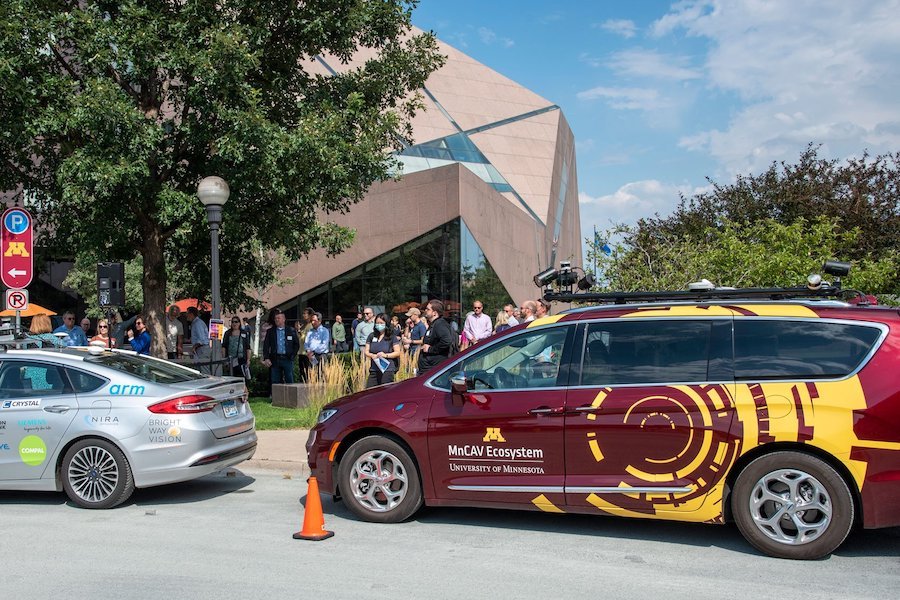Autonomous van gives UMN researchers the ability to better study self-driving vehicles

Researchers across the University will study topics like policy, design, and equity surrounding autonomous vehicles
October 19, 2022
A maroon and gold Chrysler Pacifica Minivan pulled up to the curb outside McNamara Alumni Center late this summer. But this wasn’t any old minivan—it’s the University of Minnesota’s first, state-of-the-art autonomous research vehicle, and it just made its debut with a weeklong, 1,000+ mile journey across the state.
The vehicle is part of the Minnesota Connected and Autonomous Vehicles (MnCAV) Ecosystem, an initiative by the University of Minnesota Twin Cities’ Center for Transportation Studies that brings together interdisciplinary researchers, government, and industry partners to create and test CAVs under real-world conditions.
“As these technologies are developed and tested, it is important that they can operate in all types of conditions, including the extreme weather that we experience in Minnesota,” said Gina Baas, director of the MnCAV Ecosystem. “At the University, we want to ensure that testing and research isn’t just conducted in warm weather states.”
The idea for the program was borne out of conversations Baas had with faculty about having their own research vehicle to test out different technologies. With funding from the College of Science and Engineering and the University of Minnesota’s Office of the Vice President for Research, Baas and her team purchased a minivan and worked with a company in Michigan called DataSpeed to outfit the vehicle with the automation technology.
The vehicle receives inputs from a computer that controls the brakes, throttle, and shifter, and sensors allow the car to sense how far it is from other vehicles on the road. However, the van isn’t fully autonomous—due to Minnesota’s laws surrounding self-driving vehicles, there always has to be someone in the driver’s seat.
Researchers across the University of Minnesota can use the van to study various topics related to self-driving vehicles. The first person to use it was Department of Mechanical Engineering Professor Rajesh Rajamani.
“This vehicle is a very good asset to have because it gives us the experimental infrastructure to implement algorithms and develop technologies that address the current problems with autonomous vehicles,” said Rajamani, who is also the Benjamin Y.H. Liu / TSI Applied Technology Chair in the department.
“And it has a lot of really great LiDAR, GPS, radar, and infrared sensors on it,” he added. “So, there’s a tremendous amount of data you can collect, and a lot of different people across the University can use that data to further research.”
Rajamani and his team have been conducting a preliminary study of how the vehicle operates—and how it works in Minnesota’s environment, especially with the state’s cold winters and snowy roads. The researchers have also been working to improve some of the technical aspects of the vehicle.
“Each of the vehicle’s components are an opportunity for research,” said Brian Davis, the vehicle’s manager and a research fellow in the Department of Mechanical Engineering. “Some researchers might want to look at a low-level radar filtering technique, or some might want to look at what the vehicle’s highest level of navigation is and how it gets from point A to point B.”
Other researchers will take a broader view.
Department of Civil, Environmental, and Geo- Engineering Assistant Professor Raphael Stern plans to study how the addition of autonomous vehicles on roads would affect the overall transportation system in Minnesota. Faculty at the University of Minnesota’s Hubert H. Humphrey School of Public Affairs hope to use the vehicle to look at equity, policy, accessibility, and privacy issues surrounding connected and autonomous vehicle technologies.
The MnCAV team is also working with VSI Labs, a local company that conducts research on automated vehicle technology, to collect data on Minnesota roads and signage to see how ready the state’s infrastructure is to support CAVs.
“What’s really interesting about our program is that there are discussions around how the technology works, but also the policy implications, equity, and the design of transportation systems as they relate to CAVs,” Baas said.
“That’s the advantage that an interdisciplinary organization like Center for Transportation Studies brings to the table. We can draw on that expertise from all areas of the University.”
To see the CAVs four-day trek to eight communities, visit the CTS Drive MN tour website.
Story by Olivia Hultgren
If you’d like to support research in the University of Minnesota College of Science and Engineering, visit our CSE Giving website.
